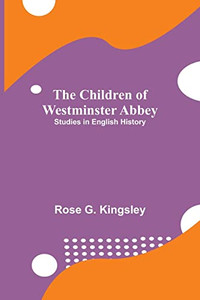
The Children Of Westminster Abbey: English History
CreateSpace Independent Publishing Platform
ISBN13:
9781545343968
$12.30
Westminster Abbey is located near the Houses of Parliament and the Thames River in London. It was built in the Gothic style. It has a huge, vaulted ceiling and pointed arches. The aisles are narrow, making the central area (the nave) seem taller, longer, and thinner than it is. There are many stone carvings decorating the abbey. Originally, they would have been brightly colored. Some 3,300 people have been buried in the abbey and its grounds. The building contains monuments, statues, gravestones, and floor slabs bearing the names of the dead. The grave of the "Unknown Warrior," whose remains were brought from Flanders (Belgium) in 1920, is in the center of the nave near the west door. History Monks of the Benedictine order of the Roman Catholic Church first settled on the site of Westminster Abbey more than 1,000 years ago. They built a monastery, or place where they could live and worship. In the 1040s King Edward the Confessor established his royal palace nearby. Edward decided to rebuild the monastery and called it West Minster (Saint Paul's Cathedral, in East London, was known as East Minster at the time). Edward died a few days after the new building was finished. His body was buried in front of the High Altar, although it was later moved. Few parts of the original West Minster remain because it was rebuilt over the years. In the 1200s King Henry III wanted a new cathedral to be built in the Gothic style that was popular at the time. His builders tore down all of the old building except for the nave. The new Westminster was designed as a monastery, a place of worship, and somewhere that monarchs could be crowned and buried. The nave was rebuilt in the same Gothic style beginning in the late 1300s. A chapel built by King Henry VII in the early 1500s was boldly decorated and contains around 100 statues of saints. It has been called one of the most perfect buildings ever constructed. The western towers were the last addition to the building. They were completed about 1745. Other additions, repairs, and improvements to the abbey were carried out over time, including replacement of most of the stained-glass windows. A great deal of repair work was necessary after the abbey was damaged during World War II. In 1965 and 1966 the community of people who use the abbey celebrated its 900th anniversary. They adopted the theme of "One People" to show that although the abbey is a Church of England building, it is also a place that serves all the people of the nation. In 1987 the United Nations Educational, Scientific and Cultural Organization (UNESCO) declared the Palace of Westminster and Westminster Abbey a World Heritage site. Page. I. The Building of the Abbey-Princess Catherine and Prince Henry. 3. II. The Conquest of Wales-Prince Alfonso. 10. III. John of Eltham, the Young Knight. 17. IV. Edward the Fifth, and Richard, Duke of York. 24. V. King Edward the Sixth. 31. VI. Miss Elizabeth Russell, "the Child of Westminster." 36. VII. The Princesses Sophia and Mary. 47. VIII. Henry Frederick, Prince of Wales. 52. IX. Henry Frederick, Prince of Wales (continued). 58. X. Lord Francis Villiers. 65. XI. Princess Anne, and Henry, Duke of Gloucester. 70. XII. William Henry, Duke of Gloucester. 78.
- | Author: Rose G. Kingsley
- | Publisher: CreateSpace Independent Publishing Platform
- | Publication Date: Apr 13, 2017
- | Number of Pages: 88 pages
- | Language: English
- | Binding: Paperback
- | ISBN-10: 1545343969
- | ISBN-13: 9781545343968
- Author:
- Rose G. Kingsley
- Publisher:
- CreateSpace Independent Publishing Platform
- Publication Date:
- Apr 13, 2017
- Number of pages:
- 88 pages
- Language:
- English
- Binding:
- Paperback
- ISBN-10:
- 1545343969
- ISBN-13:
- 9781545343968





